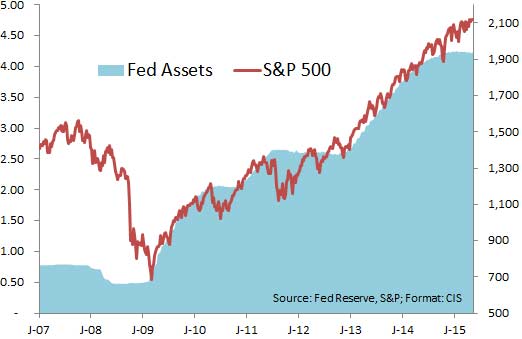Do Not Expect the Stock Growth of Recent Years to Continue
What drove the incredible returns that stocks posted from the end of 2008 through September 2015? Nothing real.

"Men, it has been well said, think in herds; it will be seen that they go mad in herds, while they only recover their senses slowly, one by one." ― Charles Mackay, Extraordinary Popular Delusions and the Madness of Crowds
Since the end of 2008 through the third quarter of 2015, Standard & Poor's 500-stock index was up about 134%. Very impressive. Many will see this number and not inquire further. We see the number in the context of other numbers and wonder how in the world it did it. What drove the market up for six years? Was it earnings? Was it a great economy? Was it value?
Let's examine the economy, in terms of gross domestic product (GDP). According to the Federal Reserve, the GDP grew 26% since the beginning of 2009, an average of 3.36% annually. The stock market grew more than five times what the economy grew. Economic growth was hardly a catalyst for the market's performance.
From just $107.88 $24.99 for Kiplinger Personal Finance
Become a smarter, better informed investor. Subscribe from just $107.88 $24.99, plus get up to 4 Special Issues

Sign up for Kiplinger’s Free Newsletters
Profit and prosper with the best of expert advice on investing, taxes, retirement, personal finance and more - straight to your e-mail.
Profit and prosper with the best of expert advice - straight to your e-mail.
Next let's look at earnings. We have heard great things about earnings for the past few years. The S&P 500's operating earnings grew 110% since 2008. However, that high jump is really just some balance sheet gymnastics; the starting point for that period of gains was when earnings were crushed due to the 2008 bear market. If you look at the index's performance from the previous market peak in June 2007 through September 2015, earnings are up only 13.85% total while the market is up 33.15%, almost 2.5 times the earnings growth. This gives a more realistic view of the long-term earnings growth. Earnings were up, but the market was up a lot more. Earnings weren't the catalyst.
Since earnings did grow, sales must have been up considerably, right? S&P data shows sales were up 9% total. Not annually, total—from the end of 2008 through the third quarter of 2015, there was only 9% sales growth. This meager sales figure gives further credence to the belief that much of the earnings over the past several years have been due to balance sheet and income statement manipulations rather than good old-fashioned business growth. Sales weren't the catalyst.
Was the market a great value in 2009? The cyclically adjusted price-earnings ratio, which is a measurement of value that was devised by Yale finance professor Robert Shiller as a way of normalizing earnings, hit a low of about 13.32. Also known as the Shiller P/E, its previous bottoms were in the single digits—for example, 6.64 in 1982, 5.57 in 1932 and 4.78 in 1921. Each bottom was less than half the 2009 low. So no, the 2009 low was no great bargain. And the Shiller P/E has doubled since 2009.
So what was the main catalyst of the market rally?
Our research shows that it was liquidity from the Fed. As the Fed pumped liquidity into the system, that liquidity found its way into stocks. The only number that comes close to having an impact on the value of stocks is the Fed's increasing its balance sheet by 128% since the beginning of 2009 (as shown in the chart below).

You can see just how much of an impact the Fed's buying binge had on the market. The chart below shows that when the Fed slowed its buying of assets, the market stalled, and when it started buying again, the market took off. Today the Fed has slowed its buying, and the market is going through some wild volatility.

(Some may retort, "But the markets made money for the past six years, so they did something right?!" To those people, I will point out that heroin dealers also make money, but it doesn't mean how they did it was right. The Fed has been acting more like a drug dealer for the past decade or more, and the markets have been its shady street corner. Investors are hooked on what the Fed is selling.)
What does this mean? Today's market is way out of whack with reality: sales growth, earnings growth and economic growth clearly do not track with the stock growth of recent years. Even with the latest correction, the market is still bloated. For it all to make sense, sales would need to catch up, showing that companies are focused on actually growing their businesses and creating better value, and the economy would need to suddenly accelerate. Otherwise, the market needs to become "real" again. This means stocks would have to fall back to where they belong, based on historical norms—to match the economic reality, that means the market could go 30% to 60% lower.
So what does an investor do? Realize that what we witnessed the past few years wasn't real, and do not expect it to continue. Carefully review your holdings and reduce risks. Eliminate the most overvalued holdings first. Don't forget to look at your mutual funds—they are made up of stocks and can be just as overvalued. Being in a mutual fund doesn't keep them from declining to normal levels.
Of course the Fed could step in and make an artificial market even more so. Could it come to the rescue again? Does it not see the damage they have already done to the markets? Does it not realize that pumping up its balance sheet only resulted in a meager increase in the economy and sales revenue, that its policy failed?
The Fed may very well be out of ammunition to prop up the economy and market. Those that are waiting for it to rescue the markets again could be sorely disappointed.
John Riley, registered Research Analyst and the Chief Investment Strategist at CIS, has been defending his clients from the surprises Wall Street misses since 1999.
Disclosure: Third party posts do not reflect the views of Cantella & Co Inc. or Cornerstone Investment Services, LLC. Any links to third party sites are believed to be reliable but have not been independently reviewed by Cantella & Co. Inc or Cornerstone Investment Services, LLC. Securities offered through Cantella & Co., Inc., Member FINRA/SIPC. Advisory Services offered through Cornerstone Investment Services, LLC's RIA. Please refer to my website for states in which I am registered.
Profit and prosper with the best of Kiplinger's advice on investing, taxes, retirement, personal finance and much more. Delivered daily. Enter your email in the box and click Sign Me Up.

In 1999, John Riley established Cornerstone Investment Services to offer investors an alternative to Wall Street. He is unique among financial advisers for having passed the Series 86 and 87 exams to become a registered Research Analyst. Since breaking free of the crowd, John has been able to manage clients' money in a way that prepares them for the trends he sees in the markets and the surprises Wall Street misses.
-
 Verizon’s 4-Line Phone Promo Offers Strong Value for Families Upgrading to Premium Devices
Verizon’s 4-Line Phone Promo Offers Strong Value for Families Upgrading to Premium DevicesFamilies can upgrade to top-tier smartphones for $25 a line with Verizon’s newest offer.
-
 Where to Store Your Cash in 2026
Where to Store Your Cash in 2026Set yourself up for success with these strategies.
-
 How Much Income You Really Need to Afford a $500,000 Home
How Much Income You Really Need to Afford a $500,000 HomeAs home prices increase, the income needed for a house is also climbing. We break down what you need to earn to afford a $500,000 home.
-
 Your Year-End Tax and Estate Planning Review Just Got Urgent
Your Year-End Tax and Estate Planning Review Just Got UrgentChanging tax rules and falling interest rates mean financial planning is more important than ever as 2025 ends. There's still time to make these five key moves.
-
 What Makes This Business So Successful? We Find Out From the Founder's Kids
What Makes This Business So Successful? We Find Out From the Founder's KidsThe children of Morgan Clayton share how their father's wisdom, life experience and caring nature have turned their family business into a respected powerhouse.
-
 Past Performance Is Not Indicative of Your Financial Adviser's Expertise
Past Performance Is Not Indicative of Your Financial Adviser's ExpertiseMany people find a financial adviser by searching online or asking for referrals from friends or family. This can actually end up costing you big-time.
-
 I'm a Financial Planner: If You're Not Doing Roth Conversions, You Need to Read This
I'm a Financial Planner: If You're Not Doing Roth Conversions, You Need to Read ThisRoth conversions and other Roth strategies can be complex, but don't dismiss these tax planning tools outright. They could really work for you and your heirs.
-
 Could Traditional Retirement Expectations Be Killing Us? A Retirement Psychologist Makes the Case
Could Traditional Retirement Expectations Be Killing Us? A Retirement Psychologist Makes the CaseA retirement psychologist makes the case: A fulfilling retirement begins with a blueprint for living, rather than simply the accumulation of a large nest egg.
-
 I'm a Financial Adviser: This Is How You Can Adapt to Social Security Uncertainty
I'm a Financial Adviser: This Is How You Can Adapt to Social Security UncertaintyRather than letting the unknowns make you anxious, focus on building a flexible income strategy that can adapt to possible future Social Security changes.
-
 I'm a Financial Planner for Millionaires: Here's How to Give Your Kids Cash Gifts Without Triggering IRS Paperwork
I'm a Financial Planner for Millionaires: Here's How to Give Your Kids Cash Gifts Without Triggering IRS PaperworkMost people can gift large sums without paying tax or filing a return, especially by structuring gifts across two tax years or splitting gifts with a spouse.
-
 'Boomer Candy' Investments Might Seem Sweet, But They Can Have a Sour Aftertaste
'Boomer Candy' Investments Might Seem Sweet, But They Can Have a Sour AftertasteProducts such as index annuities, structured notes and buffered ETFs might seem appealing, but sometimes they can rob you of flexibility and trap your capital.